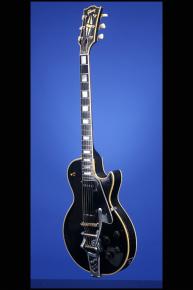A 1955 "Black Beauty"
This wonderful guitar weighs just 9.30 lbs. and has nice, fat nut width of just under 1 11/16 inches and a standard Gibson scale length of 24 3/4 inches. Solid mahogany body, one-piece mahogany neck with a medium-to-thick profile, ebony fretboard with 22 low "fretless wonder" frets and inlaid pearl block position markers. Headstock with inlaid pearl "Gibson" logo and five-piece pearl split-diamond inlay. "Les Paul Custom" on truss-rod cover. The body has seven-ply binding on the top and five-ply binding on the back, the headstock has five-ply binding, and the fretboard is single bound. Individual Kluson Super tuners with single-ring Keystone plastic buttons (tips replaced). One Alnico V pickup in the neck position with an output of 8.46k and one P-90 pickup in the bridge position with an output of 7.79k. Five-layer (black/white/black/white/black) plastic pickguard. Four controls (two volume, two tone) plus three-way selector switch. Black plastic bell-shaped "Bell" knobs. ABR-1 non-retainer Tune-O-Matic bridge and original late 1955 alloy Bigsby tailpiece. All hardware gold-plated. The serial number inked-on in yellow on the back of the headstock is "511578" The potentiometers are stamped "134 522" (Centralab May 1955), and the two tone capacitors are still the original Sprague brown waxy tubular "grey tiger" type. The previous owner has etched the number "81221" onto the end of the Bigsby tailpiece and also onto the inside of the black plastic switch cover. Housed in the original Gibson four-latch black hardshell case with yellow plush lining (9.00).
In the mid-fifties most Les Paul Customs were made with a 'stop-tailpiece' but the factory also offered a 'Bigsby Vibrato optional' to special order. Although the Bigsby is the correct late '55 alloy style we believe that this guitar left the factory with a stop-tailpiece. The most likely scenario is either that the original purchaser wan not prepared to wait for a 'special order' guitar or that when the guitar arrived at his Gibson dealer, he decided as an afterthought to have a Bigsby unit fitted to the instrument. It was fairly commonplace in those days for an authorized Gibson dealer to fit a Bigsby unit and this was most likely fitted at the time of sale. We say this because 'Factory' Bibsby guitars were fitted with a 'ground' wire that exits the body via a small hole behind the hinge-flap of the Bigsby… generally speaking a dealer-fitted unit would not have a ground wire in the late fifties. Although the Bigsby unit has been on the guitar since it was new - the ground wire was in our opinion fitted at some later point in time because it exits the body beneath the Bigsby just by the treble-side stud-hole.
According to the Gibson shipping records this guitar left the factory on November 2nd, 1955.
"In a move designed to widen the market still further for solidbody guitars, Gibson issued two new Les Paul models in 1954, the Custom and the Junior...The two-pickup Custom looked classy with its all-black finish, multiple binding, block-shaped position markers in an ebony fingerboard, and gold-plated hardware, and was indeed more expensive than the gold-top. Paul said that he chose the black colour for the Custom. 'When you're on stage with a black tuxedo and a black guitar, the people can see your hands move with a spotlight on them. They'll see your hands flying.' The Custom had an all-mahogany body, as favoured by Les Paul himself, rather than the maple/mahogany mix of the gold-top, giving the new guitar a rather mellower tone...The Les Paul Custom was promoted in Gibson catalogues as 'the fretless wonder' because of its use of very low, flat fretwire, different to the wire used on other Les Paul at the time and favoured by some players for the way it helped them play more speedily...The September 1954 pricelist showed the Les Paul Custom at $325 and the Les Paul Junior at $99.50. The gold-top meanwhile had sneaked up to $225" (Tony Bacon, 50 Years of the Gibson Les Paul, p. 25). The Custom was the first Les Paul model to receive the company's Tune-O-Matic bridge, used in conjunction with a separate bar-shaped tailpiece, which offered for the first on Gibsons the opportunity to individually adjust the length of each string, thus improving tuning accuracy.
Translate:










